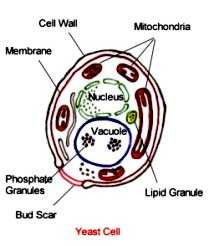Microbiology Society Biology Diagrams ADVERTISEMENTS: The below mentioned article provides an overview on the cell structure of yeast. Antony Von Leeuwenhoek (1680) was the first to describe the yeast cells. Its thallus is unicellular and non-mycelial. However, at the time of budding it rarely produces pseudo-mycelium. The individual cells are polymorphic i.e., showing different shapes, even in the same […]

Interestingly, Delobel et al., [32] used FCM to quantify the relative proportions of yeast cells in each cell cycle stage at different points of the growth curve of a population in batch culture Download scientific diagram | Schematic view of budding yeast cell cycles: Stages (a) and size (b). Scale bar on the left of panel B represents 2 μm. Images adapted from [30] (a) and [31] (b

Yeast Cell: Diagram, Cycle, & Structure Biology Diagrams
Yeast: morphology and life cycle. They are single celled fungi; Size: generally larger than most bacteria; (1-5) um wide and (5-30)um length; Shape: cell is egg shaped, some are elongated or spherical; Size and shape varies among species; Yeast cell lacks flagella and other organ of locomotion. Morphology of yeast cell 3 In the 1990's a host of cell cycle genes were identified in budding yeast, including CLN1,2: encoding G1 cyclins important for START and bud emergence. CLB1-6: encoding B-type cyclins essential for DNA synthesis and mitosis. CDC20: encoding a ubiquitin-ligase component essential for sister chromatid separa- tion and cyclin degradation in anaphase.

Figure 1: Schematic diagram of the yeast cell cycle. The budding and spindle cycle, on the basis of Byers and Goetsch 3 ; phases of the cycle are G1, S (DNA synthesis), G2/M (metaphase) and A (B) The yeast cell cycle diagram shows the phases of the cell cycle. The abbreviations used for yeast cell cycle stand for the standard terms: 1 M, Mitosis; S, Synthesis; G 1 and from publication This will also help you to draw the structure and diagram of cell structure of yeast. The yeasts are unicellular fungi. Cells may remain attached in short chains forming a pseudomycelium, but they do not produce true mycelium. The cells are extremely variable in shape being globose, oval, elongated, or rectangular.
